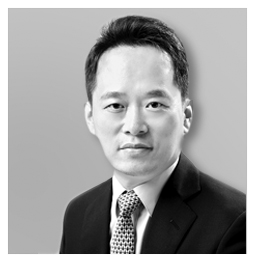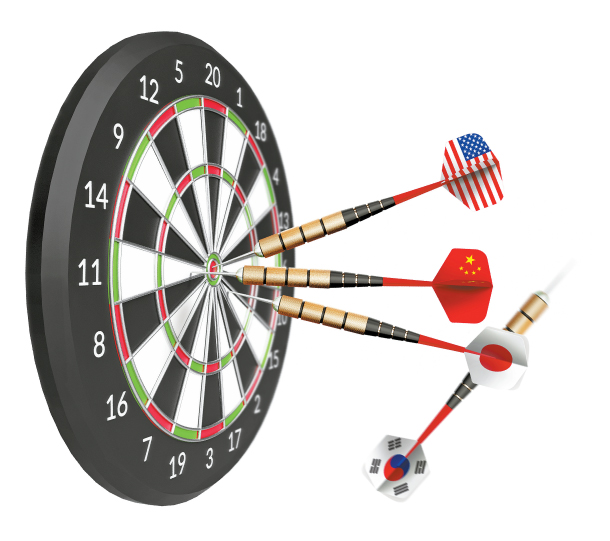The sole underperformer

The author is an editorial writer of the JoongAng Ilbo.
“All it takes is one lightning bolt,” said the International Monetary Fund (IMF) chief Christine Lagarde earlier this year as she warned governments around the world to prepare for an “economic storm.” The IMF said trade wars, monetary tightening, Brexit and Chinese risks are the four clouds hanging over the global economy this year. The first-quarter data, however, defied the IMF’s pessimism. In the United States, the unemployment rate hit 3.6 percent in the first quarter, the lowest in a half of a century. China surprised the markets by registering 6.4 percent growth in the first quarter. Even Japan is finally expected to emerge from zero-growth territory with an estimated 1.0 percent growth this year, compared to the 0.8 percent last year.
But Korea is the sole underperformer in the global economy. Despite its heavy dependence — as high as 50 percent — on exports to the three large booming economies, its gross domestic product (GDP) retreated by 0.4 percent in the first quarter. It is no longer growing in line with the three major markets, except during times of crisis. So what has caused Korea’s decoupling?
The United States, with its per capita income twice Korea’s, grew by an annualized 3.2 percent in the first quarter, double Korea’s 1.6 percent during the same period. Korea also compares poorly with China. China’s per capita income neared $10,000 last year. Korea passed the $10,000 milestone in 1994, but its income retreated during the 1997-98 Asian financial crisis. Although it stayed above the threshold from 1999, its growth slowed to under 6 percent. China, however, still manages to grow more than 6 percent a year.
Although the Korean government refuses to see the picture, we cannot but attribute the slow growth of the economy to its weakened fundamentals if we take a look at the issue from a broader perspective.

Korea could stay ahead of — or at least in line with — the global economy largely thanks to its leadership in chip making. However, the cyclical bust in semiconductors coupled with a deepening trade war between the United States and China has exposed Korea’s weakness in its overreliance on chip making. The outlook on semiconductors remains dim. DRAM chip prices have fallen 40 percent from their peak levels. As a result, the operating profit of Samsung Electronics plummeted by 56 percent on year in the second quarter. Adding to its woes, Japan has introduced restrictions of the export of three key materials needed to manufacture semiconductors and displays in Korea.
Aside from the chip sector, our mainstay industries have already turned southward due to strong competition from China. Chinese names have become dominant players in areas in which Korea used to be strong — automobiles, shipbuilding, steelmaking and even smartphones.
Hyundai Motor and its sister company Kia Motors, whose vehicles used to be the fifth biggest seller in China, had to close down their production lines in the world’s largest market from this year due to poor local demand. Samsung Electronics phones barely sell in China, and many of its electronics products also have been replaced by China’s domestic brands. Korea’s shipbuilding has been under restructuring. Daewoo Shipbuilding & Marine Engineering is merging with Hyundai Heavy Industries. Midsized Sungdong Shipbuilding & Marine Engineering is also on the verge of going bankrupt. In the meantime, Korean steelmakers are struggling to maintain profit in the context of a supply glut and cheaper Chinese products on top of the decreasing demand in China.
It would be better if Korea could restore growth — a key barometer of the strength of a country’s economic fundamentals. In June, Fitch Ratings cut its prospect for Korea’s growth to 2.0 percent from 2.5 percent, citing the extra burden faced by Korea Inc. in the face of higher labor costs resulting from the rapid increase in the minimum wage. Goldman Sachs also slashed its estimate for Korea’s growth — to 2.1 percent from 2.3 percent — given the slow recovery in chip demand as a result of the extended Sino-U.S. trade war and sluggish exports.
The Korean government also downgraded its growth estimate to a range of 2.4 to 2.5 percent from a range of 2.6 to 2.7 percent. Local and foreign institutions are in general agreement that Korea’s growth would end the year at slightly over 2.0 percent or even under. There are few ways to expand our GDP for now. The GDP is an aggregate of value from corporate, consumer and government spending plus trade. The economy cannot grow without investment to expand domestic demand and strengthen external demand.
Facility investment as well as construction investment have turned negative since last year. As a result, consumption and hiring remain sluggish. When they will pick up is uncertain. The domestic economy has slackened primarily due to rapid increases — nearly 30 percent in just two years — in the minimum wage and a universal cutback in the workweek to 52 hours. Frustrated with the unfriendly business environment, Korea Inc. is increasingly taking money out of the country. Overseas direct investments (ODI) by Korean manufacturers last year doubled to $16.4 billion from the previous year.
Waning economic fundamentals
You don’t have to see Korean ODI negatively as the companies must go to foreign countries to seek revenues beyond the small local market. Hyundai Motor has been running its production lines in America, China, Russia and Mexico to target their bigger markets. Samsung Electronics also has been manufacturing its products in China as it is its largest market.
But industrial drain is inevitable if the exodus exceeds the normal level. Capital investment elsewhere means fewer jobs in Korea. Korea’s younger people cannot find jobs, and anyone over the age of 50 is insecure about job prospects because of the waning employment at home.
Although the overall employment rate has stayed relatively stable, jobs for the people in their 30s and 40s — the core of our working population — have been diminishing at an alarming pace. The liberal Moon Jae-in administration cannot be entirely blamed for the phenomenon, since the middle age group’s employment has increased since 2015. And yet jobs outside the retiree group have been declining under the Moon administration. Those in their 30s and 40s cannot find work as companies are increasingly building their production lines and businesses overseas.
The economy cannot be sustained if the drain in the industrial sector continues.
JoongAng Ilbo, July 8, Page 24










with the Korea JoongAng Daily
To write comments, please log in to one of the accounts.
Standards Board Policy (0/250자)